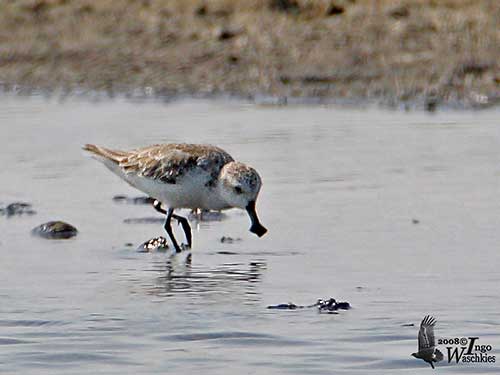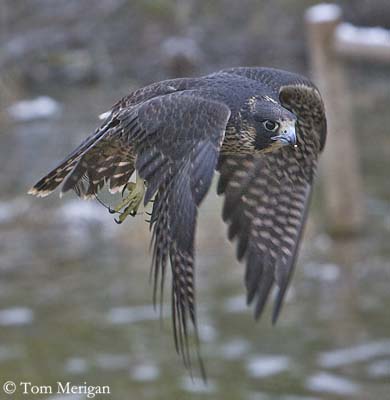

Bécasseau spatule
Ingo Waschkies
Bird Photography
WRANGEL ISLAND BIRD SPECIES
Arctic Ocean
Wrangel Island is situated in the Arctic Ocean, between the Chukchi Sea and the East Siberian Sea. It lies at 140 km from the mainland. The closest island is the small, rocky Herald Island, 60 km to the east.
The island and adjacent waters are a “strict nature reserve” since 1976, and it is highly protected against human activities except for scientific purposes.
Wrangel Island covers a surface of 7,600 km² and is about 125 km wide. It consists of a southern coastal plain of 15 km, a central belt of low mountains, and a northern coastal plain as wide as 25 km. The highest point of the island is Sovetskaya Mountain, with 1,096 metres above sea-level. The east-west mountain range terminates at sea cliffs.
In spite of severe climate, Wrangel Island is a shelter for numerous animal species. It is a breeding ground for polar bears, with as many as 400 females landing here in winter to raise their young. But seals, walruses, whales, lemmings, Arctic foxes and Arctic wolves are present in large numbers. Domestic reindeer were introduced in the 1950s, like the musk ox.
During summer, many types of birds nest on this island. About 400 plant species are growing on the tundra.
Wrangle Island is probably the last place where woolly mammoths lived. Following the disappearance of these animals from Eurasia and North America 10,000 years ago, a population of 500/1000 mammoths survived on the island for a further 6,000 years and managed to maintain a stable population. Their extinction was probably caused by rapid change in the environment such as climate change or arrival of humans.
For all these reasons, Wrangel Island was proclaimed the northernmost World Heritage Site in 2004.
But Wrangel Island is also a breeding ground for numerous bird species. It is the only Snow Goose’s nesting colony in Asia, and the Spoon-billed Sandpiper is an endemic breeding species. We can find here the largest seabird colonies on the Chukchi Sea, and this place is the northernmost nesting ground for more than 100 migrating bird species, including the endangered Peregrine Falcon. The island is the densest nesting area for the Snowy Owl.
About 169 bird species are described on the island, but not all of them nest here. Various and unique birds such as hummingbirds and the Yellow-rumped (myrtle) Warbler are sometimes blown by the winds and reach the island, but probably they do not nest here.
Wrangle Island was described by John Muir in 1881 as “This grand wilderness in its untouched freshness”. This place is one of the world’s more restricted nature reserves, and requires several government permits to visit. It is a very fragile place…
Text by Nicole Bouglouan
Sources:
Wikipedia, the free encyclopaedia
BBC News - Mammoths' extinction not due to inbreeding, study finds
Bird list:
Arctic Redpoll or Hoary Redpoll - Acanthis hornemanni - Sizerin blanchâtre
Arctic Tern - Sterna paradisaea – Sterne arctique
Arctic Warbler - Phylloscopus borealis - Pouillot boréal
Baird’s Sandpiper - Calidris bairdii - Bécasseau de Baird
Black Guillemot - Cepphus grylle - Guillemot à miroir
Black-legged Kittiwake - Rissa tridactyla - Mouette tridactyle
Brant Goose - Branta bernicla - Bernache cravant
Brown Shrike - Lanius cristatus - Pie-grièche brune
Buff-breasted Sandpiper - Tryngites subruficollis - Bécasseau roussâtre
Cliff Swallow - Petrochelidon pyrrhonota - Hirondelle à front blanc
Common Eider - Somateria mollissima - Eider à duvet
Common Murre - Uria aalge - Guillemot de Troïl
Common Raven – Corvus corax - Grand corbeau
Common Redpoll - Acanthis flammea - Sizerin flammé
Common Ringed Plover - Charadrius hiaticula - Pluvier grand-gravelot
Crested Auklet - Aethia cristatella - Starique cristatelle
Dark-eyed Junco – Junco hyemalis – Junco ardoisé
Dunlin - Calidris alpina - Bécasseau variable
Eastern Yellow Wagtail - Motacilla tschutschensis - Bergeronnette de Béringie
Glaucous-winged Gull - Larus glaucescens - Goéland à ailes grises
Glaucous Gull - Larus hyperboreus - Goéland bourgmestre
Golden-crowned Sparrow - Zonotrichia atricapilla - Bruant à couronne dorée
Grey Plover - Pluvialis squatarola - Pluvier argenté
Gyrfalcon - Falco rusticolus - Faucon gerfaut
Herring Gull – Larus argentatus – Goéland argenté
Horned Lark - Eremophila alpestris – Alouette hausse-col
Horned Puffin - Fratercula corniculata - Macareux cornu
Ivory Gull - Pagophila eburnea - Mouette blanche
King Eider - Somateria spectabilis - Eider à tête grise
Kittlitz’s Murrelet - Brachyramphus brevirostris - Guillemot de Kittlitz
Lapland Longspur - Calcarius lapponicus - Bruant lapon ou Plectrophane lapon
Little Auk or Dovekie - Alle alle - Mergule nain
Little Bunting - Emberiza pusilla - Bruant nain
Long-tailed Duck - Clangula hyemalis - Harelde boréale
Long-tailed Jaeger - Stercorarius longicaudus - Labbe à longue queue
Northern Pintail - Anas acuta - Canard pilet
Pacific Golden Plover - Pluvialis fulva - Pluvier fauve
Parasitic Jaeger or Arctic Skua - Stercorarius parasiticus - Labbe parasite
Pectoral Sandpiper - Calidris melanotos - Bécasseau tacheté
Pelagic Cormorant - Phalacrocorax pelagicus - Cormoran pélagique
Peregrine Falcon - Falco peregrinus - Faucon pèlerin
Pomarine Skua or Jaeger - Stercorarius pomarinus - Labbe pomarin
Red-breasted Merganser - Mergus serrator - Harle huppé
Red Knot - Calidris canutus - Bécasseau maubèche
Red Phalarope - Phalaropus fulicarius - Phalarope à bec large
Red-throated Diver (Loon) - Gavia stellata - Plongeon catmarin
Red-throated Pipit - Anthus cervinus - Pipit à gorge rousse
Ross’s Goose - Chen rossii – Oie de Ross
Ross’s Gull - Rhodostethia rosea - Mouette de Ross
Rough-legged Buzzard - Buteo lagopus - Buse pattue
Ruddy Turnstone - Arenaria interpres - Tournepierre à collier
Sabine’s Gull - Xema sabini - Mouette de Sabine
Savannah Sparrow – Passerculus sandwichensis - Bruant des prés
Sharp-tailed Sandpiper - Calidris acuminata - Bécasseau à queue pointue
Short-eared Owl - Asio flammeus - Hibou des marais
Siberian Accentor - Prunella montanella - Accenteur montanelle
Snow Bunting - Plectrophenax nivalis - Bruant des neiges ou Plectrophane des neiges
Snow Goose - Chen caerulescens - Oie des neiges
Snowy Owl - Bubo scandiacus – Harfang des neiges
Spoon-billed Sandpiper - Eurynorhynchus pygmeus - Bécasseau spatule
Thick-billed Murre - Uria lomvia - Guillemot de Brünnich
Tree Swallow – Tachycineta bicolour – Hirondelle bicolore
Tufted Puffin - Fratercula cirrhata - Macareux huppé
White Wagtail - Motacilla alba - Bergeronnette grise
Sources :

Tom Merigan
Tom Merigan’s Photo Galleries